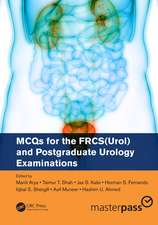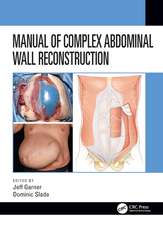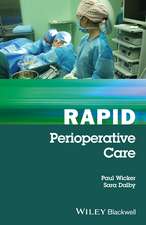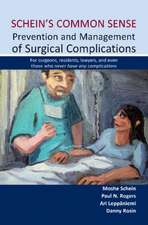Revival: Rat Hybridomas and Rat Monoclonal Antibodies (1990): CRC Press Revivals
Autor Herve Bazinen Limba Engleză Paperback – 28 ian 2019
| Toate formatele și edițiile | Preț | Express |
|---|---|---|
| Paperback (1) | 482.35 lei 6-8 săpt. | |
| CRC Press – 28 ian 2019 | 482.35 lei 6-8 săpt. | |
| Hardback (1) | 1326.99 lei 6-8 săpt. | |
| CRC Press – 20 sep 2017 | 1326.99 lei 6-8 săpt. |
Din seria CRC Press Revivals
-
 Preț: 227.06 lei
Preț: 227.06 lei -
 Preț: 369.73 lei
Preț: 369.73 lei -
 Preț: 369.73 lei
Preț: 369.73 lei - 15%
 Preț: 461.03 lei
Preț: 461.03 lei - 15%
 Preț: 461.03 lei
Preț: 461.03 lei - 20%
 Preț: 93.77 lei
Preț: 93.77 lei -
 Preț: 244.94 lei
Preț: 244.94 lei - 18%
 Preț: 1054.71 lei
Preț: 1054.71 lei - 24%
 Preț: 358.70 lei
Preț: 358.70 lei - 13%
 Preț: 338.33 lei
Preț: 338.33 lei - 15%
 Preț: 585.27 lei
Preț: 585.27 lei - 18%
 Preț: 1000.27 lei
Preț: 1000.27 lei -
 Preț: 322.97 lei
Preț: 322.97 lei -
 Preț: 469.34 lei
Preț: 469.34 lei - 13%
 Preț: 338.33 lei
Preț: 338.33 lei -
 Preț: 469.34 lei
Preț: 469.34 lei -
 Preț: 469.34 lei
Preț: 469.34 lei - 46%
 Preț: 203.95 lei
Preț: 203.95 lei -
 Preț: 322.97 lei
Preț: 322.97 lei - 15%
 Preț: 545.64 lei
Preț: 545.64 lei - 5%
 Preț: 1032.66 lei
Preț: 1032.66 lei - 25%
 Preț: 456.63 lei
Preț: 456.63 lei - 35%
 Preț: 1169.12 lei
Preț: 1169.12 lei - 15%
 Preț: 540.06 lei
Preț: 540.06 lei - 15%
 Preț: 461.03 lei
Preț: 461.03 lei -
 Preț: 489.00 lei
Preț: 489.00 lei - 36%
 Preț: 1681.14 lei
Preț: 1681.14 lei -
 Preț: 322.97 lei
Preț: 322.97 lei -
 Preț: 469.34 lei
Preț: 469.34 lei - 5%
 Preț: 1537.37 lei
Preț: 1537.37 lei - 15%
 Preț: 461.03 lei
Preț: 461.03 lei - 26%
 Preț: 1215.08 lei
Preț: 1215.08 lei - 15%
 Preț: 698.17 lei
Preț: 698.17 lei -
 Preț: 469.34 lei
Preț: 469.34 lei -
 Preț: 469.34 lei
Preț: 469.34 lei - 15%
 Preț: 461.03 lei
Preț: 461.03 lei - 19%
 Preț: 216.07 lei
Preț: 216.07 lei - 15%
 Preț: 461.36 lei
Preț: 461.36 lei - 50%
 Preț: 912.50 lei
Preț: 912.50 lei - 18%
 Preț: 1544.82 lei
Preț: 1544.82 lei - 26%
 Preț: 1018.41 lei
Preț: 1018.41 lei
Preț: 482.35 lei
Nou
Puncte Express: 724
Preț estimativ în valută:
92.31€ • 96.02$ • 76.21£
92.31€ • 96.02$ • 76.21£
Carte tipărită la comandă
Livrare economică 12-26 aprilie
Preluare comenzi: 021 569.72.76
Specificații
ISBN-13: 9781138561649
ISBN-10: 1138561649
Pagini: 534
Dimensiuni: 178 x 254 x 27 mm
Greutate: 0.45 kg
Ediția:1
Editura: CRC Press
Colecția CRC Press
Seria CRC Press Revivals
ISBN-10: 1138561649
Pagini: 534
Dimensiuni: 178 x 254 x 27 mm
Greutate: 0.45 kg
Ediția:1
Editura: CRC Press
Colecția CRC Press
Seria CRC Press Revivals
Public țintă
ProfessionalCuprins
Introduction
Part I IMMUNOCYTOMAS in LOUVAIN (LOU) RATS.
Chapter 1
Rat Immuoglobulins.
Chapter 2
The LOUVAIN (LOU) Rats.
Chapter 3
Rat Immunocytomas (IR).
Part II PRODUCTION of RAT-RAT HYBRIDOMAS.
Chapter 4
Fusion Cell Lines.
Chapter 5
Immunization of Rats.
Chapter 6.I
Fusion Procedure.
Chapter 6.II
Rat Hybridoma Prodcution: Scanning electron Microscopy of a Fusion Experiment
Chapter 7
Selective Growth of Hybrids.
Chapter 8
Cloning.
Chapter 9.I
Screening of Monoclonal Antibodies Directed Against Soluble Antigens
Chapter 9.II
Screening of Hybrid Supernatants for Monoclonal Antibodies Against Cellular Antigens
Chapter 10
Isotyping of Rat Monoclonal Antibodies.
Chapter 11
Adaptation to In Vivo Culture. Freezing and Thawing.
Chapter 12
Freezing and Thawing
Part III PRODUCTION, PURIFICATION, FRAGMENTATION and LABELING of MONOCLONAL ANTIBODIES.
Chapter 13
In Vitro Production of Rat Monoclonal Antibodies.
Chapter 14
In Vivo Production of Rat Monoclonal Antibodies.
Chapter 15
Purification of Rat Monoclonal Antibodies from Ascitic Fluid - Serum or Culture Supernatant.
Chapter 16
Quality Control of Purified Antibodies.
Chapter 17
Fragmentation of Rat Monoclonal Antibodies.
Chapter 18
Labeling of Monoclonal Antibodies.
Part IV EXAMPLES of PRODUCTION and CHARACTERIZATION of RAT-RAT HYBRIDOMAS AGAINST VARIOUS Ag.
Chapter 19.I
Rat Monoclonal Antibodies Against Murine Immunoglobulins.
Chapter 19.II
Allotype Specific Monoclonal Antibodies to Rat Kappa Light Chain.
Chapter 19.III
Application of Rat Hybridomas to Studies on Ocular Immunobiology.
Chapter 19.IV
Rat Monoclonal Antibodies Against Rabbit Immunoglobulin.
Chapter 19.V
Preparation of Anti-Human IgG Monoclonal Antibodies Using Rat x Rat Hybridoma System.
Chapter 19.VI
Rat Monoclonal Antibodies Against Human Immunoglobulin.
Chapter 19.VII
Production and Characterization of Rat Monoclonal Antibodies Directed Against Human Apolipoprotein B.
Chapter 19.VIII
Studies on Rat-Rat Hybridoma Technique and its Application to Obtain Rat Monoclonal Antibodies Anti-Horse-radish Peroxidase.
Chapter 19.IX
Rat-Rat and Rat-Mouse Hybridomas Secreting Rat Monoclonal Anti-Horse-radish Peroxidase.
Chapter 19.X
LOU Rat Monoclonal Antibodies Against Xenopus Vitellogenin.
Chapter 19.XI
Production and Characterization of Rat-Rat Hybridomas Against DNP-Hapten. Rat x Rat Hybridomas Against Cellular Antigens.
Chapter 20.I
Rat Monoclonal Antibodies Against Human Leukocyte Differentiation Antigens.
Chapter 20.II
Rat Monoclonal Antibodies Specific for T Lymphocytes.
Chapter 21.I
Rat Monoclonal Antibodies Against Streptococcus mutans and Bacteroides gingivalis.
Chapter 21.II
A Specific Rat Monoclonal Antibody Against Yersinia enterocolitica Serogroup 0:8.
Chapter 21.III
Production of Rat Hybridoma Directed Against Yersinia enterocolitica.
Chapter 22
Rat Monoclonal Antibodies Against Viral Antigens.
Chapter 23
Contribution of Rat Monoclonal Antibodies to the Study of Schistosoma mansoni Infections.
Part V SPECIFIC USES and PROPERTIES of RAT MONOCLONAL ANTIBODIES.
Chapter 24.I
Mouse Immunoglobulin Isotyping.
Chapter 24.II
Humoral Immune Suppression of Mice by Monoclonal Rat Anti-Mouse µHeavy Chain Antibodies.
Chapter 24.III
Rat Monoclonal Antibodies Against Mouse IgE.
Chapter 24.IV
Purification of Mouse Monoclonal Antibodies by Immunoaffinity Chromatography.
Chapter 24.V
Screening of Mouse Monoclonal Antibodies.
Chapter 24.VI
Use of Rat Monoclonal Antibodies in Immunohistochemistry Investigations.
Chapter 24.VII
Use of Rat-Rat Monoclonal Antibodies Labeled with Fluorochrome.
Chapter 25.I
Use of Rat Monoclonal Anti-Rat Allotype Antibodies in Immunohistoperoxidase Technique and ELISA.
Chapter 25.II
Use of Anti-Rat Kappa Light Chain Allotype Monoclonal Antibodies for the Quantification of Rat Monoclonal Antibodies in Ascitic Fluid or Serum.
Chapter 26
Extracorporeal Removal of Arteriogenic Particles by Use of Rat Monoclonal Antibody Coupled to Sepharose as Specific Immunosorbent.
Chapter 27
Antibacteria Antigens, Especially Streptococcus mutans.
Chapter 28
Mercury-Induced Autoimmunity Production of Monoclonal Autoantibodies.
Chapter 29
Rat Monoclonal Antibodies to Plant Pathogens.
Chapter 30.I
Rat Monoclonal Antibodies for Complement-Mediated and Cell-Medicated Cytolysis.
Chapter 30.II
Rat Antibodies and K Cells.
Chapter 31
Absence of Viral Particles in Rat Hybridomas - An Ultrastructural Study.
Chapter 32
Role of CODATA-HDB in the Centralization and Distribution of Information Concerning the Rat Hybridomas.
Chapter33
List of Monoclonal Antibodies.
Part I IMMUNOCYTOMAS in LOUVAIN (LOU) RATS.
Chapter 1
Rat Immuoglobulins.
Chapter 2
The LOUVAIN (LOU) Rats.
Chapter 3
Rat Immunocytomas (IR).
Part II PRODUCTION of RAT-RAT HYBRIDOMAS.
Chapter 4
Fusion Cell Lines.
Chapter 5
Immunization of Rats.
Chapter 6.I
Fusion Procedure.
Chapter 6.II
Rat Hybridoma Prodcution: Scanning electron Microscopy of a Fusion Experiment
Chapter 7
Selective Growth of Hybrids.
Chapter 8
Cloning.
Chapter 9.I
Screening of Monoclonal Antibodies Directed Against Soluble Antigens
Chapter 9.II
Screening of Hybrid Supernatants for Monoclonal Antibodies Against Cellular Antigens
Chapter 10
Isotyping of Rat Monoclonal Antibodies.
Chapter 11
Adaptation to In Vivo Culture. Freezing and Thawing.
Chapter 12
Freezing and Thawing
Part III PRODUCTION, PURIFICATION, FRAGMENTATION and LABELING of MONOCLONAL ANTIBODIES.
Chapter 13
In Vitro Production of Rat Monoclonal Antibodies.
Chapter 14
In Vivo Production of Rat Monoclonal Antibodies.
Chapter 15
Purification of Rat Monoclonal Antibodies from Ascitic Fluid - Serum or Culture Supernatant.
Chapter 16
Quality Control of Purified Antibodies.
Chapter 17
Fragmentation of Rat Monoclonal Antibodies.
Chapter 18
Labeling of Monoclonal Antibodies.
Part IV EXAMPLES of PRODUCTION and CHARACTERIZATION of RAT-RAT HYBRIDOMAS AGAINST VARIOUS Ag.
Chapter 19.I
Rat Monoclonal Antibodies Against Murine Immunoglobulins.
Chapter 19.II
Allotype Specific Monoclonal Antibodies to Rat Kappa Light Chain.
Chapter 19.III
Application of Rat Hybridomas to Studies on Ocular Immunobiology.
Chapter 19.IV
Rat Monoclonal Antibodies Against Rabbit Immunoglobulin.
Chapter 19.V
Preparation of Anti-Human IgG Monoclonal Antibodies Using Rat x Rat Hybridoma System.
Chapter 19.VI
Rat Monoclonal Antibodies Against Human Immunoglobulin.
Chapter 19.VII
Production and Characterization of Rat Monoclonal Antibodies Directed Against Human Apolipoprotein B.
Chapter 19.VIII
Studies on Rat-Rat Hybridoma Technique and its Application to Obtain Rat Monoclonal Antibodies Anti-Horse-radish Peroxidase.
Chapter 19.IX
Rat-Rat and Rat-Mouse Hybridomas Secreting Rat Monoclonal Anti-Horse-radish Peroxidase.
Chapter 19.X
LOU Rat Monoclonal Antibodies Against Xenopus Vitellogenin.
Chapter 19.XI
Production and Characterization of Rat-Rat Hybridomas Against DNP-Hapten. Rat x Rat Hybridomas Against Cellular Antigens.
Chapter 20.I
Rat Monoclonal Antibodies Against Human Leukocyte Differentiation Antigens.
Chapter 20.II
Rat Monoclonal Antibodies Specific for T Lymphocytes.
Chapter 21.I
Rat Monoclonal Antibodies Against Streptococcus mutans and Bacteroides gingivalis.
Chapter 21.II
A Specific Rat Monoclonal Antibody Against Yersinia enterocolitica Serogroup 0:8.
Chapter 21.III
Production of Rat Hybridoma Directed Against Yersinia enterocolitica.
Chapter 22
Rat Monoclonal Antibodies Against Viral Antigens.
Chapter 23
Contribution of Rat Monoclonal Antibodies to the Study of Schistosoma mansoni Infections.
Part V SPECIFIC USES and PROPERTIES of RAT MONOCLONAL ANTIBODIES.
Chapter 24.I
Mouse Immunoglobulin Isotyping.
Chapter 24.II
Humoral Immune Suppression of Mice by Monoclonal Rat Anti-Mouse µHeavy Chain Antibodies.
Chapter 24.III
Rat Monoclonal Antibodies Against Mouse IgE.
Chapter 24.IV
Purification of Mouse Monoclonal Antibodies by Immunoaffinity Chromatography.
Chapter 24.V
Screening of Mouse Monoclonal Antibodies.
Chapter 24.VI
Use of Rat Monoclonal Antibodies in Immunohistochemistry Investigations.
Chapter 24.VII
Use of Rat-Rat Monoclonal Antibodies Labeled with Fluorochrome.
Chapter 25.I
Use of Rat Monoclonal Anti-Rat Allotype Antibodies in Immunohistoperoxidase Technique and ELISA.
Chapter 25.II
Use of Anti-Rat Kappa Light Chain Allotype Monoclonal Antibodies for the Quantification of Rat Monoclonal Antibodies in Ascitic Fluid or Serum.
Chapter 26
Extracorporeal Removal of Arteriogenic Particles by Use of Rat Monoclonal Antibody Coupled to Sepharose as Specific Immunosorbent.
Chapter 27
Antibacteria Antigens, Especially Streptococcus mutans.
Chapter 28
Mercury-Induced Autoimmunity Production of Monoclonal Autoantibodies.
Chapter 29
Rat Monoclonal Antibodies to Plant Pathogens.
Chapter 30.I
Rat Monoclonal Antibodies for Complement-Mediated and Cell-Medicated Cytolysis.
Chapter 30.II
Rat Antibodies and K Cells.
Chapter 31
Absence of Viral Particles in Rat Hybridomas - An Ultrastructural Study.
Chapter 32
Role of CODATA-HDB in the Centralization and Distribution of Information Concerning the Rat Hybridomas.
Chapter33
List of Monoclonal Antibodies.
Descriere
The purpose of this book is to provide information which supports the fact that rat hybridomas are no more difficult to develop than mouse hybridomas. This is the first book devoted to the development of rat hybridomas. It includes theories, step-by-step techniques, ingredients and apparatus.




















